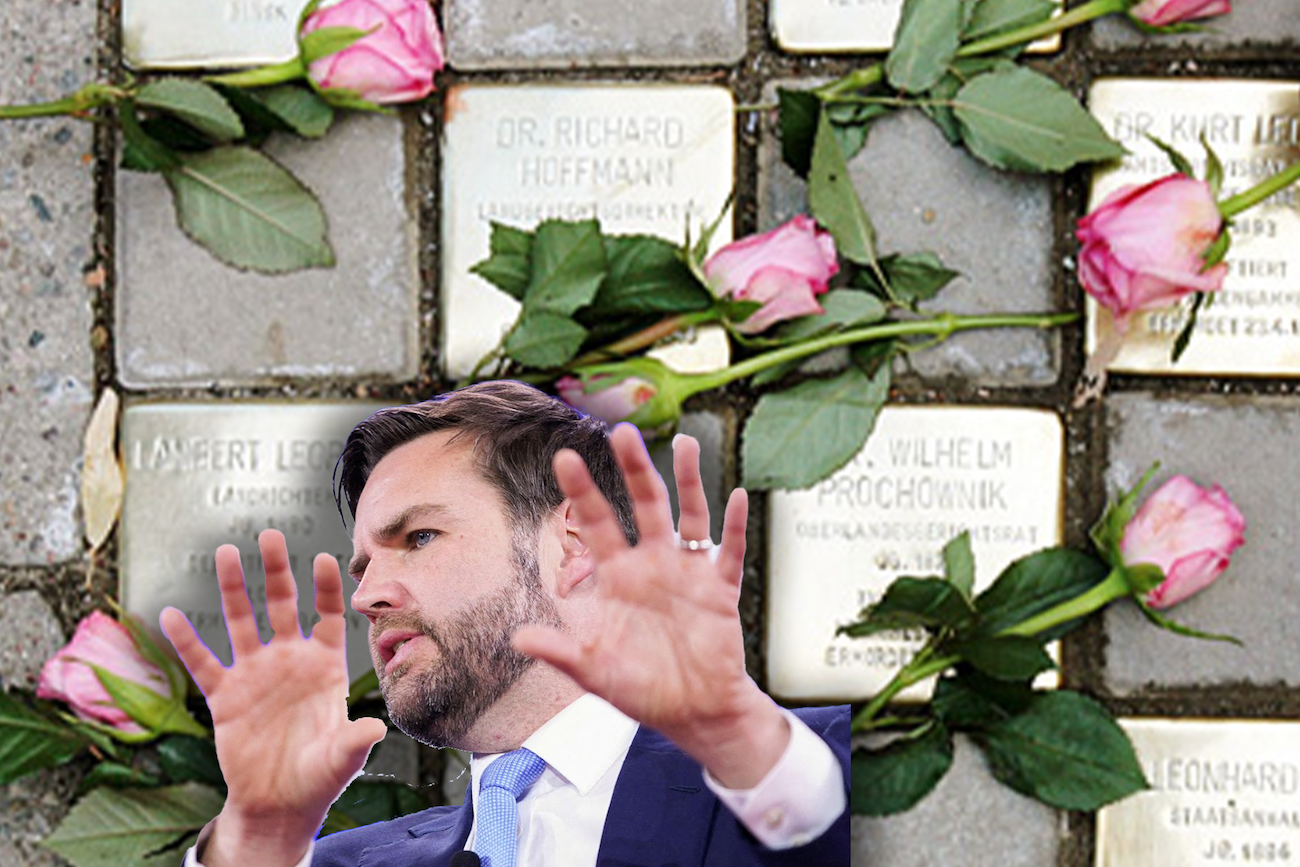The Inscrutable J.D. Vance: How Germany ‘Remembers’ to Stop History From Repeating Itself
- The Vice President’s speech at the Munich Conference demonstrates an ahistorical perspective that chooses to ignore the lessons of history.

In recent weeks, Vice President J.D. Vance and Elon Musk have chosen to wade into German politics, expressing support for the far-right AfD which has tried to minimize the importance of Germany’s Nazi past. Their support is also linked to them elevating far-right groups in the United States. Both Vance and Musk seem to imply that Germany needs to stop being apologetic about their past. Having lived in Germany as a middle school student a few years ago, I have a different view on what we, in the United States, can learn from how history is currently being remembered in Germany.
A few years ago, when I lived in Germany, I often found myself tripping over small, metallic cobblestones. Some were on my way to school; others were in parks and in front of shops and residential buildings. I found these stones everywhere I went. I learned that these Stolpersteine, or stumbling stones had been installed past a powerful act of remembrance. Each stone is a memorial to a person who faced Nazi persecution. The “Stolpersteine” lists the person’s name, birthdate, where they were taken, and, if known, their eventual fate. Started in Germany in 1992, this project has now spread to over 24 countries.
Whenever I saw one of these stones, I would stop to read its inscription. Some listed children, as young as three years, who had been taken to a Nazi camp. In front of some houses, I saw ten such memorials, indicating the destruction of an entire family. In some cases, family members had been sent to different camps, ripping them apart. When I read the stone of someone who had escaped to another country, I was happy for them, but also sad that they had to flee their home.
I read hundreds of such stones. In each one, you get a glimpse into an individual’s story, and you understand how large this catastrophe was. Each marker asks you to reflect on the history of where you stand, if only for a few moments. These reminders come to you continuously, as you are going about your normal day. I now find myself reflecting on how a similar project could help heal our divided nation.
For me, memorials are not static, time needs to be taken to understand them and see how they speak to people currently.
Last summer, I visited the Freedom Monument Sculpture Park in Montgomery, Alabama. This memorial helps visitors understand how large a role enslavement played in the founding of our nation. While there, I got a better understanding of how something so far removed from us in time still shapes our lives. The Freedom Monument is powerful and essential; but, like many American memorials, it requires effort to visit. What if, like in Germany, we built smaller memorials all over the country, as constant reminders of our past mistakes?
For example, an often-neglected part of American history is Japanese internment camps. During World War II, over 120,000 Japanese Americans were forced into detention camps because of racist and unfounded fears that they were spies for Japan. Their only “crime” was being of Japanese descent. Many of those who faced this unjust incarceration were from the Seattle area, where I live, taken from their homes on the very streets where I walked and played. These were not death camps like the ones in Nazi Germany, but they still destroyed lives and created generational trauma. What if we had memorials to remember the names of those who were taken? At a time when many of our country’s leaders are talking about putting migrants in detention camps, such memorials could provide us with warnings from the past.
Another part of our history that we often look away from is the impact of our prison system. The documentary film, The 13th discusses how, after slavery was abolished, the U.S. continued to use forced labor through its prison population, primarily Black men. This exploitative practice benefited some of America’s richest cities. One of these is Sugar Land, a wealthy and diverse suburb of Houston, Texas. In 2018, construction work on a planned school led to the discovery of the remains of 95 persons, who are believed to have been African American prisoners.
During the Jim Crow era, prisoners had been forced to work under a brutal system that leased them out to private companies to work long hours for little or no wages. Along with their remains, archaeologists found chains, which were likely used to restrain the workers. The use of forced prison labor was widespread in the sugar plantations of Texas– and in other parts of the country. This history is not discussed very often. But we are all part of this story– whether we like it or not. What if, as a nation, we commemorated these 95 men, and others like them, with our own version of stepping stones? What would we learn about ourselves and what could young people like me take away from this knowledge? Perhaps such memorials could help us have a deeper conversation about the continuing injustices of our prison-industrial complex.
For me, memorials are not static, time needs to be taken to understand them and see how they speak to people currently. Vice President Vance’s speech at the Munich Conference demonstrates an ahistorical perspective that chooses to ignore the lessons of history. It is up to us, as young Americans, to learn from the mistakes of our ancestors to create a better present and future. Just as in Germany, we must recognize how historical wrongs still affect our social fabric, we can then use that knowledge to make amends. As a country, we like large-scale monuments. But accessible public memorials and everyday markers like Germany’s stumbling stones, can provide us with spaces to remember, reflect, and think about how we can avoid repeating past mistakes and crimes.
Samara Desai is a ninth-grader from Seattle, Washington. She likes to play basketball, chess, and tennis and predict the ending of movies.



Such a thoughtful piece. Thank You for sharing your perspective. I know that others will be touched, moved and inspired by your words. Well-written and so very timely!! Thank You, Samara!! 🫶